Homer, Alaska
Homer is a city in Kenai Peninsula Borough in the U.S. state of Alaska. It is 218 mi (351 km) southwest of Anchorage. According to the 2010 Census, the population is 5,003, up from 3,946 in 2000. Long known as the "Halibut Fishing Capital of the World", Homer is also nicknamed "the end of the road", and more recently, "the cosmic hamlet by the sea".
Geography
Homer is located at 59°38'35" North, 151°31'33" West (59.643059, −151.525900).[4] The only road into Homer is the Sterling Highway.[5]
Homer is on the shore of Kachemak Bay on the southwest side of the Kenai Peninsula. Its distinguishing feature is the Homer Spit, a narrow 4.5 mi (7.2 km) long gravel bar that extends into the bay, on which is located the Homer Harbor.
Much of the coastline, as well as the Homer Spit, sank dramatically during the Good Friday earthquake in March 1964. After the earthquake, very little vegetation was able to survive on the Homer Spit.
The town has a total area of 25.5 square miles (66 km2), of which 15 square miles (39 km2) are land and 10.5 square miles (27 km2) are covered by water.[6]
Climate
As with much of South-central Alaska, Homer has a moderate subarctic coastal climate (Köppen Dsc), which causes its weather to be moderate compared to interior Alaska. Winters are snowy and long, but not particularly cold, considering the latitude, with the average January high only slightly below freezing. The annual snowfall averages 50 inches (127 cm) per season, falling primarily from November through March, with some accumulation in October and April but rarely in May. Homer receives only about 25 inches of rainfall annually due to the influence of the Chugach Mountains to the southeast, which shelter it from the Gulf of Alaska. Seven days have a minimum 0 °F (−18 °C) or below annually, and Homer falls in USDA Plant Hardiness Zones 6a.[7] Summers are cool due to the marine influence, with 75 °F (24 °C) maxima or minima remaining at or above 55 °F (13 °C) being extremely rare. Extreme temperatures have ranged from −24 °F (−31 °C) on January 28–29, 1989, up to 81 °F (27 °C) on July 10, 1993.[8]
| Climate data for Homer, Alaska (Airport), 1981–2010 normals,[9] extremes 1932–present | |||||||||||||
|---|---|---|---|---|---|---|---|---|---|---|---|---|---|
| Month | Jan | Feb | Mar | Apr | May | Jun | Jul | Aug | Sep | Oct | Nov | Dec | Year |
| Record high °F (°C) | 57 (14) |
53 (12) |
54 (12) |
65 (18) |
72 (22) |
80 (27) |
81 (27) |
78 (26) |
69 (21) |
64 (18) |
58 (14) |
52 (11) |
81 (27) |
| Mean maximum °F (°C) | 44.1 (6.7) |
44.1 (6.7) |
45.5 (7.5) |
53.8 (12.1) |
62.5 (16.9) |
67.3 (19.6) |
69.0 (20.6) |
69.5 (20.8) |
62.3 (16.8) |
54.7 (12.6) |
46.9 (8.3) |
45.0 (7.2) |
71.5 (21.9) |
| Average high °F (°C) | 30.8 (−0.7) |
32.7 (0.4) |
36.6 (2.6) |
44.1 (6.7) |
51.8 (11.0) |
57.8 (14.3) |
61.2 (16.2) |
60.9 (16.1) |
55.0 (12.8) |
44.6 (7.0) |
35.5 (1.9) |
33.0 (0.6) |
45.4 (7.4) |
| Average low °F (°C) | 18.8 (−7.3) |
19.8 (−6.8) |
23.2 (−4.9) |
29.8 (−1.2) |
37.1 (2.8) |
43.5 (6.4) |
48.0 (8.9) |
46.9 (8.3) |
41.1 (5.1) |
31.6 (−0.2) |
23.5 (−4.7) |
21.1 (−6.1) |
32.1 (0.1) |
| Mean minimum °F (°C) | −0.8 (−18.2) |
2.1 (−16.6) |
8.5 (−13.1) |
18.6 (−7.4) |
29.3 (−1.5) |
36.0 (2.2) |
41.0 (5.0) |
38.6 (3.7) |
29.9 (−1.2) |
19.2 (−7.1) |
8.3 (−13.2) |
3.4 (−15.9) |
−5.7 (−20.9) |
| Record low °F (°C) | −24 (−31) |
−19 (−28) |
−21 (−29) |
−9 (−23) |
6 (−14) |
27 (−3) |
34 (1) |
31 (−1) |
20 (−7) |
0 (−18) |
−7 (−22) |
−16 (−27) |
−24 (−31) |
| Average precipitation inches (mm) | 2.63 (67) |
1.71 (43) |
1.65 (42) |
1.07 (27) |
0.82 (21) |
0.82 (21) |
1.55 (39) |
2.34 (59) |
3.31 (84) |
2.57 (65) |
2.79 (71) |
3.08 (78) |
24.34 (618) |
| Average snowfall inches (cm) | 9.1 (23) |
9.6 (24) |
7.0 (18) |
1.9 (4.8) |
trace | 0 (0) |
0 (0) |
0 (0) |
0 (0) |
2.6 (6.6) |
7.0 (18) |
10.2 (26) |
47.4 (120) |
| Average precipitation days (≥ 0.01 in) | 14.9 | 11.5 | 10.7 | 9.9 | 9.3 | 9.4 | 11.9 | 13.8 | 15.9 | 14.3 | 13.8 | 15.8 | 151.2 |
| Average snowy days (≥ 0.1 in) | 8.0 | 6.4 | 5.2 | 1.9 | 0.1 | 0 | 0 | 0 | 0 | 2.2 | 5.4 | 7.6 | 36.8 |
| Mean monthly sunshine hours | 93 | 141.3 | 186 | 240 | 279 | 270 | 248 | 186 | 150 | 124 | 90 | 62 | 2,069.3 |
| Mean daily sunshine hours | 3 | 5 | 6 | 8 | 9 | 9 | 8 | 6 | 5 | 4 | 3 | 2 | 6 |
| Percent possible sunshine | 43 | 54 | 50 | 55 | 52 | 48 | 45 | 39 | 39 | 40 | 39 | 33 | 45 |
| Average ultraviolet index | 0 | 0 | 1 | 3 | 4 | 5 | 5 | 4 | 2 | 1 | 0 | 0 | 2 |
| Source 1: NOAA[8][10] | |||||||||||||
| Source 2: Weather Atlas (sun and uv)[11] | |||||||||||||
History
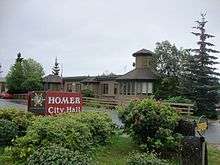
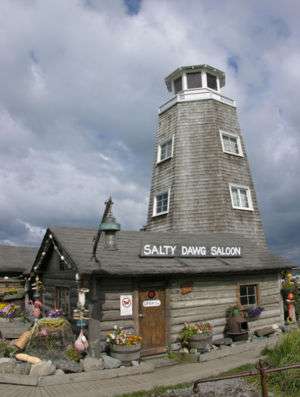
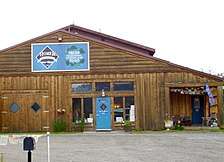

Tiller digs indicate that early Alutiiq people probably camped in the Homer area, although their villages were on the far side of Kachemak Bay.
Coal was discovered in the area in the 1890s. The Cook Inlet Coal Fields Company built a town, dock, coal mine, and railroad at Homer. Coalmining in the area continued until World War II. It is estimated that 400 million tons of coal deposits are still present in the area.
Homer was named for Homer Pennock, a goldmining company promoter, who arrived in 1896 on the Homer Spit and built living quarters for his crew of 50 men. However, goldmining was never profitable in the area.
Another earlier settlement, Miller's Landing, was named after a Charles Miller, who homesteaded in the area around 1915. According to local historian Janet Klein, he was an employee of the Alaska Railroad and had wintered company horses on the beach grasses on the Homer Spit. He built a landing site in a small bight in Kachemak Bay, where supply barges from Seldovia could land and offload their cargos.[12] Miller's landing was legally considered a census-designated place separate from Homer until it was annexed in 2002, but has always been locally considered part of Homer.
Halibut and salmon sport fishing, along with tourism and commercial fishing are the dominant industries. Homer co-hosted the 2006 Arctic Winter Games. The Alaska Maritime National Wildlife Refuge and the Kachemak Bay Research Reserve co-host a visitor center with interpretive displays known as the Alaska Islands and Ocean Visitor Center,[13] and a cultural and historical museum there is called the Pratt Museum.
Demographics
| Historical population | |||
|---|---|---|---|
| Census | Pop. | %± | |
| 1940 | 325 | — | |
| 1950 | 307 | −5.5% | |
| 1960 | 1,247 | 306.2% | |
| 1970 | 1,083 | −13.2% | |
| 1980 | 2,209 | 104.0% | |
| 1990 | 3,660 | 65.7% | |
| 2000 | 3,946 | 7.8% | |
| 2010 | 5,003 | 26.8% | |
| Est. 2019 | 5,922 | [3] | 18.4% |
| U.S. Decennial Census | |||
Homer first appeared on the 1940 U.S. Census as an unincorporated village. It formally incorporated in 1964.
As of the 2010 United States Census, there were 5,003 people, 2,235 households, and 1,296 families residing in the city. The population density was 361.7 people per square mile (139.8/km²). There were 2,692 housing units at an average density of 194.6 per square mile (75.2/km²). The racial makeup of the city was 89.3% White, 4.1% American Indian and Alaska Native, 1.0% Asian, 0.4% African American, 0.1% Pacific Islander, 0.6% from other races, and 4.5% from two or more races. Hispanics and Latinos of any race were 2.1% of the population.[14]
There were 2,235 households of which 27.2% had children under the age of 18 living with them, 44.3% were married couples living together, 9.3% had a female householder with no husband present, 4.3% had a male householder with no wife present, and 42.0% were non-families. 33.7% of all households were made up of individuals, and 11.0% had someone living alone who was 65 years of age or older. The average household size was 2.21, and the average family size was 2.83.[14]
The median age in the city was 44.0 years. 21.9% of residents were under the age of 18; 6.9% were between the ages of 18 and 24; 22.2% were from 25 to 44; 34.5% were from 45 to 64; and 14.5% were 65 years of age or older. The gender makeup of the city was 49.5% male and 50.5% female.[14]
The median income for a household was $52,057, and the median income for a family was $68,455. Males had a median income of $41,581 versus $37,679 for females. The per capita income for the city was $32,035. About 3.8% of families and 7.9% of the population were below the poverty line, including 11.2% of those under age 18 and 1.4% of those age 65 or over.[14]
Education

The Kenai Peninsula Borough School District provides primary and secondary education to the community of Homer. These schools are:
- Homer High School (9-12)
- Homer Flex High School (9-12)
- Homer Middle School (7-8)
- West Homer Elementary (3-6)
- Paul Banks Elementary (K-2)
- McNeil Canyon Elementary (K-6)
- Fireweed Academy (K-6)
- Connections Homeschool Program (K-12)
The Kachemak Bay Campus of Kenai Peninsula College provides post-secondary education, as well as ESL and GED training to the community of Homer.
The Homer Public Library has enthusiastic support from the Friends of the Homer Library, established in 1948, which raised funds and support for a new library building, opened on September 16, 2006.
Media
Homer has two newspapers, the Homer Tribune, an independent weekly paper established in 1991, and the Homer News, a weekly founded in 1964 and bought in 2000 by Morris Communications.
Homer has a number of radio stations including commercial stations KWVV-FM at 103.5 FM, KGTL at 620 AM, and public radio KBBI at 890 AM.[15]
Homer receives 7 analog television stations:[16] Because the stations are rebroadcast into Homer using repeaters, their channel numbers are not the same in Homer and they were not required to participate in the transition to digital television.
Transportation
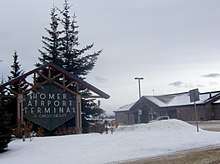
Homer is the southernmost town on the contiguous Alaska highway system. It is also part of the Alaska Marine Highway (the Alaskan ferry system). The regional airport lies near the coast as well, with local air taxis and regular scheduled commercial flights to Anchorage. Homer erected its first traffic light in 2005.[17]
The United States Coast Guard currently stations six Island Class cutters in Alaska, including one in Homer.[18][19] From February 7, 1992, to June 4, 2015, the USCGC Roanoke Island was assigned to Homer. She was retired early, and was replaced by the Sapelo. The Sapelo is scheduled to be replaced by a more modern Sentinel-class cutter.
The Coast Guard leases an anchorage on the Homer Spit.[18] The Coast Guard renewed its lease for 20 years in 2015.
Government
Homer uses a city council consisting of seven members. As of April 2020, the current mayor of Homer is Ken Castner.[20][21]
Notable people
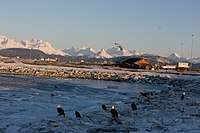
Notable people from or living in Homer include:
- Lincoln Brewster (b. 1971), Christian worship musician
- Hazel P. Heath (1909–1998), businesswoman; mayor of Homer, 1968–1976
- Tom Bodett: spokesperson, known for the Motel 6 "We'll leave the light on for you" advertisements; and writer, known for the whimsical book about Homer, As Far as You Can go Without a Passport
- Jewel (Jewel Kilcher), singer/songwriter
- Jean Keene (1923-2009), the "Eagle Lady" of Homer, known for her decades-long history of feeding bald eagles on Homer Spit
- Andre Marrou (b. 1938) was a resident of Homer when he was elected as a Libertarian to the Alaska House of Representatives in 1984
- Shannyn Moore (b. 1970), political writer based in Alaska
- Ambrose Olsen, male fashion model (1985–2010)
- Tela O'Donnell (b. 1982), Olympic female wrestler
See also
- Mile 17 fire
- Fritz Creek
- Diamond Ridge
- Kachemak City
- Homer Brewing Company
References
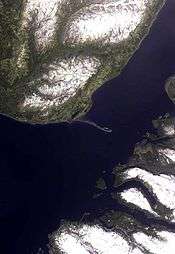
- 1996 Alaska Municipal Officials Directory. Juneau: Alaska Municipal League/Alaska Department of Community and Regional Affairs. January 1996. p. 65.
- "2019 U.S. Gazetteer Files". United States Census Bureau. Retrieved June 30, 2020.
- "Population and Housing Unit Estimates". United States Census Bureau. May 24, 2020. Retrieved May 27, 2020.
- "US Gazetteer files: 2010, 2000, and 1990". United States Census Bureau. 2011-02-12. Retrieved 2011-04-23.
- "From Ketchikan to Barrow". Alaska Magazine. 81 (5): 19. June 2015.
- "Facts & Figures | City of Homer Alaska Official Website". www.cityofhomer-ak.gov.
- "USDA Plant Hardiness Zone Map". Agricultural Research Center, PRISM Climate Group Oregon State University. Archived from the original on 2014-02-27. Retrieved 2019-11-01.
Input 99603 in the ZIP Code box.
- "NowData - NOAA Online Weather Data". National Oceanic and Atmospheric Administration. Retrieved 2019-11-01.
- Mean monthly maxima and minima (i.e. the highest and lowest temperature readings during an entire month or year) calculated based on data at said location from 1981 to 2010.
- "Station Name: AK HOMER AIRPORT". National Oceanic & Atmospheric Administration. Retrieved 2019-11-01.
- "Monthly weather forecast and climate - Homer, AK". Weather Atlas. Retrieved March 28, 2020.
- Klein, Janet (1981). A History of Kachemak Bay. Homer, Alaska: Homer Society of Natural History.
- http://www.islandsandocean.org/ Islands and Oceans homepage
- "U.S. Census website". United States Census Bureau. Retrieved 2012-10-16.
- List of radio stations in Alaska
- "TV Station List". Archived from the original on October 11, 2007.
- "Homer News Online - News". Archived from the original on 2007-09-27. Retrieved 2007-03-07.
-
Michael Armstrong (2015-06-04). "Coast Guard cutter forced into retirement". Homer News. Archived from the original on 2015-06-05.
Homer won’t lose the 18 crewmembers and their families, however. An Island Class patrol boat, the 110-foot Roanoke Island will be replaced in Homer by a sister ship, the U.S. Coast Guard Cutter Sapelo, now stationed in Sector San Juan, Puerto Rico.
-
David Mosely (2012-10-25). "Cutter crew maintains operational readiness". Coast Guard Alaska. Retrieved 2015-06-05.
The 110-foot Island-class patrol boat, homeported in Homer, Alaska, just completed a major, 135-day long, maintenance overhaul at the Coast Guard dry dock in Ketchikan. This overhaul updated the ships systems to ensure it can continue to meet its mission requirements until its scheduled replacement by one of the Coast Guard’s new fast response cutters.
- "City Council - City of Homer Alaska Official Website". City of Homer. Retrieved April 5, 2020.
- Gross, Renee, Mayor Castner and City Council clash over authority and mayoral proclamations, KBBI, 10/23/2018
External links
| Wikimedia Commons has media related to Homer, Alaska. |
| Wikivoyage has a travel guide for Homer. |


